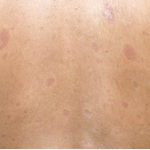Gastrointestinal disease is second only to skin involvement in SSc, and problems can occur anywhere on the gastrointestinal tract from the mouth to the anus, Dr. Silver said. Quality of life is a serious concern for SSc patients with conditions like gastric antral vascular ectasia, or “watermelon stomach,” he added. “We need better treatments,” but some existing therapies include proton-pump inhibitors for gastroesophageal reflux disease and antibiotics and motility agents for bacterial growth, he noted.
Pulmonary manifestations are another life-threatening possibility in SSc, with lung disease being the most common cause of death in these patients, Dr. Silver said. Watch and test for interstitial lung disease and pulmonary arterial hypertension (PAH), he said. “Pulmonary function tests should be done in all new scleroderma patients, and I would recommend that they be done at baseline and annually,” he said. An isolated decrease in DLCO is an early predictor of PAH and may occur 10 years or more before a diagnosis, he added.
Treatment options for SSc patients with PAH include combinations of anticoagulants, diuretics, oxygen, and digoxin, but these may not always be feasible. The EARLY trial (Endothelin Antagonist Trial in Mildly Symptomatic Pulmonary Arterial Hypertension) of bosentan may offer new hope for SSc patients who have mild PAH, he said. Other possible PAH therapies are the newly approved riociguat and macitentan, as well as selexipag, which is still in trials, “so the armaments to treat PAH are increasing,” Dr. Silver said.
Newer therapies for SSc include immunosuppressive agents and stem-cell therapy, Dr. Silver said. Although he was “a little bit pessimistic about cytokine-blocking therapy,” he spoke about the potential efficacy of stem-cell therapy. While it has a treatment-related mortality of about 5% to 10%, there is dramatic improvement in skin score and thickening. Use caution with patients who have heart disease, he advised.
While new classification criteria will increase the sensitivity and specificity of diagnosis, understanding the molecular events leading to fibrosis in SSc may one day lead to more effective treatments for this disease, Dr. Silver concluded.
Susan Bernstein is a writer based in Atlanta.
